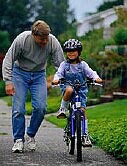
WEDNESDAY, Dec. 30 (HealthDay News) — It sounds simple enough: Kids need to be active. When they are, they’re less likely to be overweight and prone to the health risks that accompany extra pounds.
But how do you get kids moving? And not just moving, but doing the “right” type of physical activity? Therein lies the rub.
Obesity is at epidemic proportions among America’s youth. According to the U.S. Centers for Disease Control and Prevention, the percentage of obese teens and adolescents has roughly tripled in the past three decades, going from 6.5 percent to 17 percent among preteens and 5 percent to 17.6 percent among teens.
Eating a healthy diet, of course, can help fight obesity in kids. But health experts agree that physical activity is crucial, too. Making sure kids develop the physical activity habit early — and keep it — can help ensure that they will keep a healthy body weight as well.
Turning the concept of regular physical activity into reality, though, doesn’t mean simply signing them up for T-ball. It might mean you have to direct their exercise activities and disguise them as play.
“There is too much focus on doing sports and not enough focus on moving,” said Dr. Teri McCambridge, a sports medicine pediatrician in Baltimore who chairs the Council on Sports Medicine and Fitness for the American Academy of Pediatrics.
Rule number one, in her mind, is to make fitness fun.
“Make it fun and don’t make it seem like exercise,” she said. “Ideas to get kids active would include riding their bikes, making an outdoor scavenger hunt where they have to run, skip, hop, crawl to find different things, making an obstacle course, playing leap frog, playing capture the flag, playing freeze tag.”
Children and teens should fit in an hour or more of such physical activity a day, according to the CDC.
And if you’re trying to instill this habit in kids, no ducking out for coffee or heading to the movies while the kids exercise, McCambridge said. “Lead by example,” she urged.
Some parents swear by enrolling children in organized sports as soon as the kids can hold a ball or other equipment, but some fitness experts are wary of this approach. Enrolling a child in organized sports too early can cause kids who aren’t as coordinated as their peers to quit early, McCambridge said. And those who are very talented are apt to burn out because they’ve simply played too much.
Participating in sports at too young an age isn’t wise, agreed Pete McCall, an exercise physiologist at the American Council on Exercise, in San Diego. That’s especially true, he said, if children devote all of their time to one sport.
“Kids who specialize in one sport are developing overuse injuries,” McCall said.
Another danger of playing sports too young? “Kids aren’t being taught how to move,” he said. “They are being taught a position — goalie, outfielder.”
It’s better, McCall said, to focus on letting young children play in an unstructured way.
He suggests simply scheduling time at a playground “and letting them figure it out for themselves.” Children from about ages 3 to 6 can also learn movement skills from gymnastic classes, McCall said.
Later, sports can keep the kids moving, agreed McCall and McCambridge. But McCall advised holding off on organized sports until age 9 or 10.
Once kids are enmeshed in sports, suggest that they try many sports, and not stick with just one, he said.
He applauds a movement in some schools that have turned physical education classes into more of a health club environment, exposing students to different types of activities and downplaying competition.
Helping kids focus on play and the joy of movement, as well as skill acquisition, rather than the importance of winning and not losing, should also go a long way toward creating a lifelong exerciser, the two sports fitness experts agreed.
More information
The U.S. Centers for Disease Control and Prevention has more on physical activity for kids.

